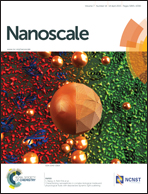Oxidized/reduced graphene nanoribbons facilitate charge transfer to the Fe(CN)63−/Fe(CN)64− redox couple and towards oxygen reduction†
Abstract
This study investigated the synthesis of graphene oxide nanoribbons (GONRs) and graphene nanoribbons (GNRs) from multiwalled carbon nanotubes (MWCNTs), and the behavior of thin films of MWCNTs, GONRs, and GNRs on a glassy carbon surface in the presence of two redox probes (Fe(CN)63−/Fe(CN)64− and O2) employing cyclic voltammetry, electrochemical impedance spectroscopy, and hydrodynamic voltammetry (HV) as a simple procedure for characterizing these films. The feasibility of using these electrochemical techniques for this purpose opens up the possibility of applying them to biosensors and electrocatalysts using surface-supported MWCNT, GONR, and GNR materials. GNR1 resembles an internodal segment of bamboo cut lengthwise, with a shallow troughing at its center, while GNR2 resembles stacked ribbons, each ∼16 nm wide, with points of structural damage and points of four-ribbon connection measuring 60 nm or wider, sufficiently catalytic for the oxygen reduction reaction to occur, unlike the other modified electrodes investigated in acidic, 0.1 M KH2PO4 (pH 7.0), and 0.1 M KOH solutions (HV results). Transmission electron microscopy and thermogravimetric analysis were employed to characterize the MWCNTs, GONRs, and GNRs.


 Please wait while we load your content...
Please wait while we load your content...